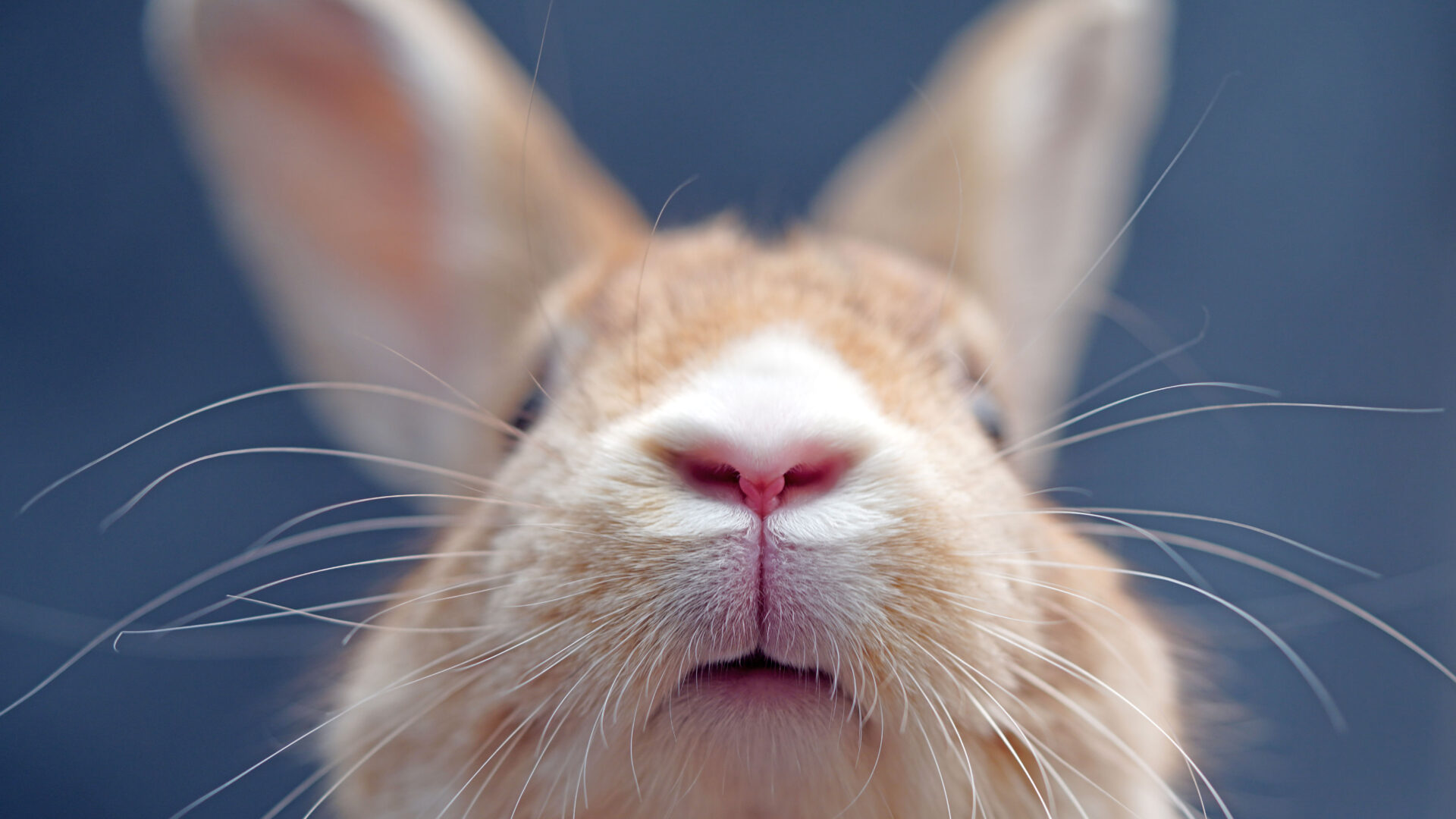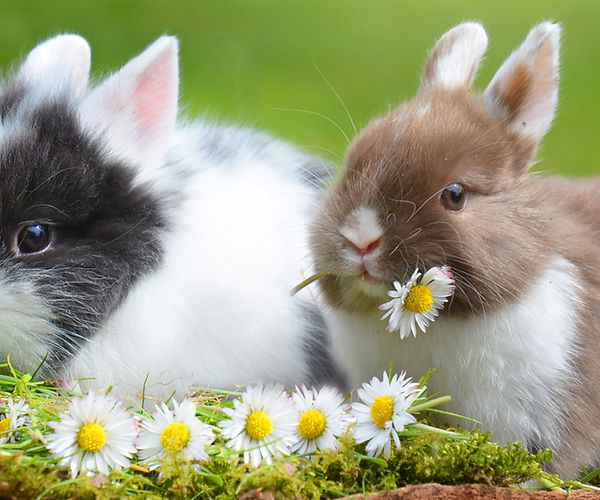
Rabbit pellets may not look very appetizing to most, but your rabbit would beg to differ! This is because rabbits are coprophagic animals, meaning they eat cecotropes, which are nutrient-rich pellets similar to feces that contain the products of cecal fermentation (also known as hindgut fermentation) [1]. Cecal fermentation occurs in the region of the digestive tract called the cecum [1]. Rabbits produce cecotropes throughout the day and consume them directly from their rectum in a process known as cecotrophy [1]. In other words, they eat their own feces!
While this process may seem surprising or abnormal to concerned rabbit owners, cecotrophy is not only normal but essential for healthy rabbits. However, disruption of microorganisms in the cecum that allows cecal fermentation to occur can result in a dysbiotic state that inhibits normal cecotrope production and leaves rabbits susceptible to life-threatening health issues.
Why Should Rabbits Eat Their Poop?
Although rabbits may appear to be eating their own poop, cecotropes are actually very different.
Rabbits, guinea pigs, chinchillas, and other small mammals have small body shapes and accordingly small digestive tracts that are unable to extract nutrients from food at an optimal rate [2]. These animals also lack certain enzymes to help break down and extract nutrients from their fibrous diet [1]. Evolution has helped some small herbivores solve this conundrum by developing a symbiotic relationship with microorganisms in the cecum, where microorganisms are able to colonize and grow rapidly under favorable conditions, while the rabbit is able to obtain the products of microbial fermentation from food that could not otherwise be digested [3]. Specifically, the gut microbiome is able to hydrolyze the plant-heavy, fibrous diet of rabbits with bacterial enzymes, which host rabbit enzymes cannot do [1]. Because rabbits consume directly from their rectum, owners actually rarely observe normal cecotropes [4]. Healthy cecotropes may appear as multiple, soft pellets stuck together [4].
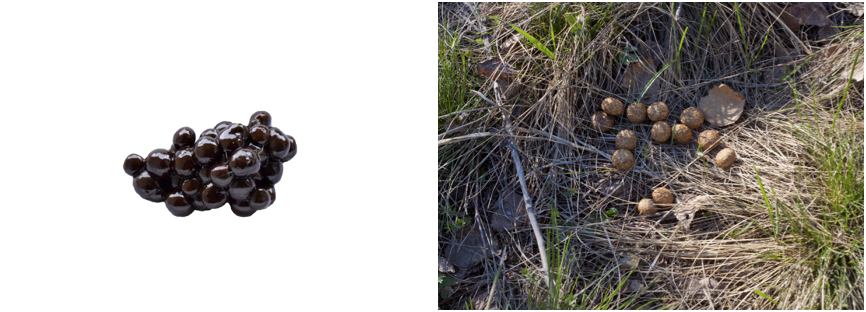
The image on the left is a nutrient-rich cecotrope, which bears a close resemblance to a blackberry. The image on the right depicts hard rabbit feces, which is nutrient poor.
A health-state cecal microbiome accounts for approximately 30% to 50% of a rabbit’s overall energy requirement, with cecotropes accounting for approximately 30% of a rabbit’s nitrogen intake [2,5]. Cecotropes also contain high levels of essential vitamins [6]. Hindgut fermentation is a longer process than normal digestion, and so rabbits increase their nutritional content by eating partially digested nutrients. This is why rabbits have two types of feces: hard (nutrient-poor) and soft (nutrient-rich cecotropes) [6]. Beyond helping rabbits meet nutritional needs, hindgut fermentation is critical for proper liver functioning, immune system functioning, and more [6,7].
Cecal microflora is notably different in sick rabbits versus healthy rabbits. In a normal state, the cecum hosts a wide variety of anaerobic organisms to perform the hindgut fermentation that produces cecotropes. Anaerobic organisms in the cecum include but are not limited to Bacteroides species, gram-negative oval and fusiform rods, amoeba, and protozoa [4]. Additionally, low amounts of the yeast species are also present in the cecum when the microbiome is balanced. However, dysbiotic cecal states create a setting that allows yeast and opportunistic bacteria such as Escherichia coli and Clostridium species to proliferate [4]. Gram-positive Clostridium may also take advantage of excess sugars and produce a toxin that causes enterotoxemia and potentially death [4].
How Can I Tell if My Rabbit’s Gut Is Healthy?
Diet is often the primary culprit for cecal dysbiosis, as higher sugar and simple carbohydrate diets encourage yeast overgrowth in a rabbit’s gut and subsequent imbalance in the microbiome [7]. The reduction and/or absence of a healthier, higher fiber diet results in excessive fermentation [4]. Rabbit owners may mistake impaired cecotrope production for diarrhea. However, rabbits impacted by an imbalanced microbiome often still pass low nutrient, hard stools. The watery, impaired cecotrope produced from a dysbiotic rabbit cecum can also be pungent and thick [4].
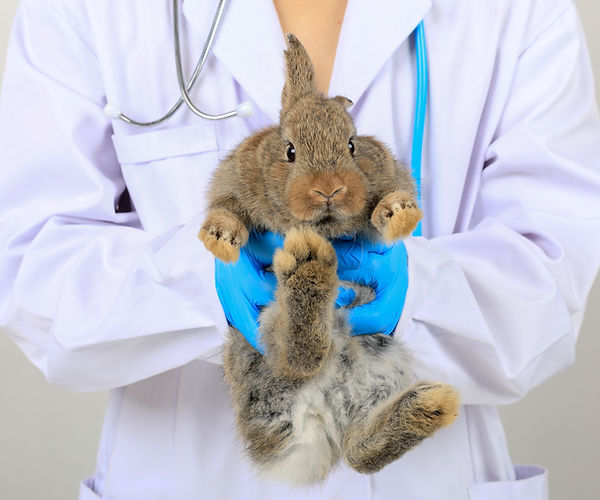
If you think your rabbit may have an imbalance in their cecal microbiome, the best thing you can do is get a quick and accurate diagnosis from your rabbit veterinarian as soon as you notice symptoms. A veterinarian may suggest lifestyle changes in addition to supportive care and in more severe cases transfaunation (transfer of rumen fluid and its associated microorganisms) or feeding of cecotropes from healthy rabbits [4].
Assessing The Health of Your Rabbit’s Gut Microbiome
Considering the importance of understanding the severity of your rabbit’s cecal dysbiosis, diagnostic tools to assess the health state of your rabbit’s cecum and cecotropes are critical in delivering quality clinical care. Although culture-based tests have historically been lauded as the standard to characterize the rabbit microbiome, scientific research has provided increasing evidence for the diagnostic benefits of Next-Gen Sequencing (NGS) technology [7]. Conventional culture-based tests have significant limitations in sensitivity to various microorganisms, as many remain undetected by culture methods [2,7]. One study reported that while analysis of the rabbit cecal microbial community using culture techniques has been the established standard, “such techniques reveal only 20-40% of the real bacterial richness” and that NGS technology has “demonstrated that the rabbit’s cecum harbors 80-96% of unknown bacterial species” [2]. Culture-based diagnostics for the rabbit cecum is thus particularly problematic when assessing microbiome health, and so having the diagnostic knowledge to assign appropriate medical intervention is key.
The MiDOG All-in-One Microbial Test utilizes NGS technology to detect and quantify microbial DNA through untargeted and comprehensive sequencing and quantitative comparisons to reference databases. The MiDOG NGS technology provides a useful opportunity to shed light on the microbial makeup of your rabbit’s cecal microbiome for clinical application. The MiDOG microbial test is grounded on scientific research that provides veterinarians DNA evidence for the guided treatment of rabbit cecal dysbiosis. A MiDOG microbial test provides the technologies for the accurate identification of all microorganisms within a pet’s sample, independent of culture.
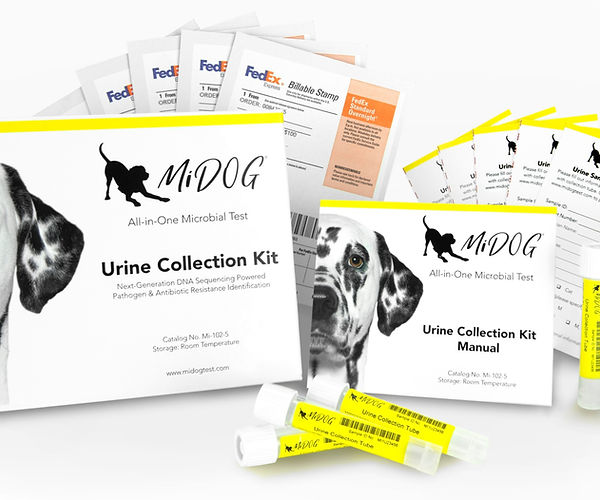
Find out if your vet uses MiDOG before you book your next appointment!
For health-related questions about your rabbit or other exotic pet, reach out to a veterinarian that specializes in exotic pets.
References:
[1] Jenkins J. R. (2004). Gastrointestinal Diseases. Ferrets, Rabbits, and Rodents, 161–171. https://doi.org/10.1016/B0-72-169377-6/50018-6
[2] Bagóné Vántus, Viola & Kovacs, Melinda & Zsolnai, Attila. (2014). The rabbit caecal microbiota: development, composition and its role in the prevention of digestive diseases – a review on recent literature in the light of molecular genetic methods. Acta Agraria Kaposváriensis. 18. 55-65.
[3] Kieckhäven, S. & Wolf, Petra. (2016). Investigations on the intestinal microbiome in rabbits – A review. Züchtungskunde. 88. 208-215.
[4] Oglesbee, B. L., & Lord, B. (2020). Gastrointestinal Diseases of Rabbits. Ferrets, Rabbits, and Rodents, 174–187. https://doi.org/10.1016/B978-0-323-48435-0.00014-9
[5] Vella D, Donnelly TM. Basic Anatomy, Physiology and Husbandry. In Quesenberry K, Carpenter J (eds): Ferrets, Rabbits, and Rodents: Clinical Medicine and Surgery, 3rd ed. St. Louis: Elsevier, 2012, P 161-163.
[6] Wang, Y., Xu, H., Sun, G., Xue, M., Sun, S., Huang, T., Zhou, J., Loor, J. J., & Li, M. (2019). Transcriptome Analysis of the Effects of Fasting Caecotrophy on Hepatic Lipid Metabolism in New Zealand Rabbits. Animals : an open access journal from MDPI, 9(9), 648. https://doi.org/10.3390/ani9090648
[7] Kylie, J., Weese, J., & Turner, P. (2018). Comparison of the fecal microbiota of domestic commercial meat, laboratory, companion, and shelter rabbits (Oryctolagus cuniculi). BMC Veterinary Research, 14(1). doi: 10.1186/s12917-018-1464-6
Categories: Exotic Pets, Gastrointestinal Health, Gut Microbiome, Next-Gen DNA Sequencing Technology, Pet Health, Safety and Wellness, Pet Parents, Rabbits
